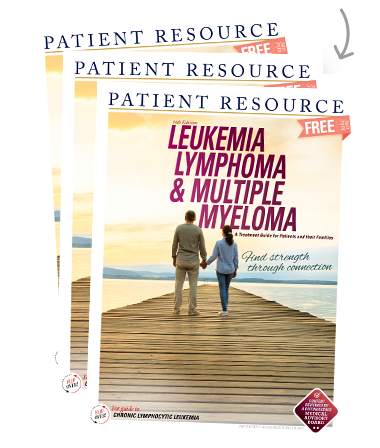Leukemias
Side Effects
Your multidisciplinary health care team is equipped to help you manage all aspects of your life affected by cancer. Supportive care consists of a range of services designed to help navigate a cancer diagnosis and treatment. These may also be referred to as palliative care or comfort care and symptom management.
Many people use supportive care to manage physical side effects, but it can also be used to help you manage the emotional, practical, spiritual, financial and family-related challenges associated with cancer.
Ask your team how to take advantage of the supportive care services available to you.
Potentially Severe Side Effects
Serious side effects can occur with certain treatments. Ask your doctor whether you are at risk for them from the therapies in your treatment plan, how to identify the symptoms and when to seek emergency care. Report symptoms immediately so they can be treated promptly.
- Infection can occur as a result of a low white blood cell count (neutropenia) or other factors. Contact your doctor immediately – do not wait until the next day – if you have any of these symptoms: oral temperature over 100.4 °F, chills or sweating; body aches, chills and fatigue; coughing, shortness of breath or painful breathing; abdominal pain; sore throat; mouth sores; painful, swollen or reddened skin; pus or drainage from an open cut or sore; pain or burning during urination; pain or sores around the anus; or vaginal discharge or itching. If you cannot reach your doctor, go to the emergency room. Prompt treatment can be life-saving.
- Immune-related adverse events (irAEs) may occur with certain immunotherapy drugs if the immune system becomes overstimulated by treatment and causes inflammation in one or more organs or systems in the body. Some irAEs can develop rapidly, becoming severe and even life-threatening without immediate medical attention.
- Cytokine release syndrome can occur if immune cells affected by treatment rapidly release large amounts of cytokines into the bloodstream. Symptoms may include headache, fever, nausea, rash, low blood pressure, rapid heartbeat and difficulty breathing.
- Infusion-related reactions most frequently occur with treatment given intravenously (IV) through a vein in your arm, usually soon after exposure to the drug. Reactions are generally mild, such as itching, rash or fever. More serious symptoms, such as shaking, chills, low blood pressure, dizziness, breathing difficulties or irregular heartbeat, can be serious or even fatal without medical intervention. These reactions are most likely to occur with antibody treatments.
- Tumor lysis syndrome (TLS) may occur after the treatment of a fast-growing cancer, especially certain blood cancers. Symptoms may include vomiting, diarrhea, muscle cramps or twitches, neuropathy and decreased urination. TLS can potentially cause damage to the kidneys, heart, liver or other organs. There may also be worsening of your kidney function or increases in the level of potassium in the blood.
Common Side Effects
Most cancer treatments result in side effects (Table 1). Let your health care team know as soon as symptoms begin. The sooner they are addressed, the more comfortable you will be.
Table 1. Some Common Side Effects
| Side Effects | Symptoms |
| Anemia | Abnormally low red blood cell count |
| Bruising and bleeding | May be caused by thrombocytopenia, a lower-than-normal number of platelets in the blood |
| Bone loss | Weakened bone caused by the cancer or treatment |
| Breathing difficulty | Shortness of breath, with or without coughing; upper respiratory infection |
| Chemo brain (cognitive dysfunction) | Brain fog, confusion and/or memory problems |
| Constipation | Difficulty passing stools or less frequent bowel movements compared to your usual bowel habits |
| Diarrhea | Frequent loose or watery bowel movements that are commonly an inconvenience but can become serious if left untreated |
| Fatigue | Tiredness that is much stronger and harder to relieve than the fatigue an otherwise healthy person has |
| Fever | Raised body temperature that could signal an infection |
| Graft-versus-Host Disease (GvHD) | White blood cells from your donor (the graft) recognize healthy cells in your body (the host) as foreign and attack them |
| Hair loss (alopecia) | Hair loss on the head, face and body |
| Infertility | The inability to become or stay pregnant or to father a child |
| Lymphedema | Fluid buildup from lymph node removal that causes swelling |
| Mouth sores | Small cuts or ulcers that can affect the gums, tongue, roof of the mouth or lips |
| Nausea and vomiting | The feeling of needing to throw up and/or throwing up |
| Neuropathy | Numbness, pain, burning sensations and tingling, usually in the hands or feet at first |
| Neutropenia | Low white blood cell count that increases the risk of infection |
| Pain | Pain and aches that occur in the muscles, bones, tendons, ligaments or nerves |
| Skin reactions | Rash, redness and irritation or dry, flaky or peeling skin that may itch |



